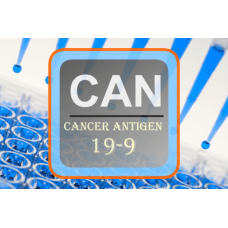Shopping Cart
0 item(s) - $0.00Cancer Antigen ELISA - CA 19-9
Availability: In Stock
Add to Compare
Enzyme Immunoassay for the Quantitative Determination of CA 19-9 in Serum
FOR RESEARCH USE ONLY. NOT FOR USE IN DIAGNOSTIC PROCEDURES
SUMMARY
CA19-9 (carbohydrate antigen 19-9, also called cancer antigen 19-9 or sialylated Lewis (a) antigen) is a tumor marker that is used primarily in the management of pancreatic cancer. CA19-9 is an antibody that binds to the tumor surface marker Sialyl-Lewis A. CA19-9 was discovered in the serum of patients with colon cancer and pancreatic cancer in 1981.
Guidelines from the American Society of Clinical Oncology discourage the use of CA19-9 as a screening test for cancer, particularly pancreatic cancer. The reason is that the test may be falsely normal (false negative) in many cases, or abnormally elevated in people who have no cancer at all (false positive). The main use of CA19-9 is therefore to see whether a pancreatic tumor is secreting it; if that is the case, then the levels should fall when the tumor is treated, and they may rise again if the disease recurs. In people with pancreatic masses, CA19-9 can be useful in distinguishing between cancer and other diseases of the gland.
CA19-9 can be elevated in many types of gastrointestinal cancer, such as colorectal cancer, esophageal cancer and hepatocellular carcinoma. Apart from cancer, elevated levels may also occur in pancreatitis, cirrhosis, and diseases of the bile ducts. It can be elevated in people with obstruction of the bile ducts.
In patients who lack the Lewis antigen (a blood type antigen on red blood cells), which is about 10% of the Caucasian population, CA19-9 is not expressed, even in those with large tumors. This is because of a deficiency of a fucosyltransferase enzyme that is needed to produce CA19-9 as well as the Lewis antigen.
PRINCIPLE OF THE TEST
The CA19-9 ELISA test is based on the principle of a solid phase enzyme-linked immunosorbent assay. The assay system utilizes a monoclonal antibody directed against a distinct antigenic determinant on the intact CA19-9 molecule is used for solid phase immobilization (on the microtiter wells). Another CA 19-9 monoclonal antibody conjugated to horseradish peroxidase (HRP) is in the antibody-enzyme conjugate solution. The test sample is allowed to react sequentially with the two antibodies, resulting in the CA19-9 molecules being sandwiched between the solid phase and enzyme-linked antibodies. After two separate incubation steps at 37°C for 90 minutes, the wells are washed with Wash Buffer to remove unbound labeled antibodies. A solution of TMB Reagent is added and incubated for 20 minutes, resulting in the development of a blue color. The color development is stopped with the addition of Stop Solution changing the color to yellow. The concentration of CA19-9 is directly proportional to the color intensity of the test sample. Absorbance is measured spectrophotometrically at 450 nm.
EXAMPLE OF STANDARD CURVE
Results of a typical standard run with optical density readings at 450 nm shown in the Y axis against Cancer Antigen concentrations shown in the X axis. This standard curve is for the purpose of illustration only, and should not be used to calculate unknowns. Each user should obtain his or her own data and standard curve.

| General | |
| ANALYTE GROUP | Cancer Antigen |
| GROUPING | Cancer |
| PRODUCT NAME | ELISA |
| STORAGE | Store the kit at 2-8°C |
| COUNTRY OF ORIGIN | USA |
| DISCOUNTS | Bulk Packaging; High Volume |
| ELISA | |
| TESTS PER KIT | 96 (12 x 8) |
| CALIBRATION RANGE | 0 - 600 U/mL (Recommended) |
United Immunoassay, Inc. © 2025


































